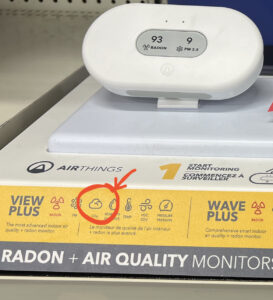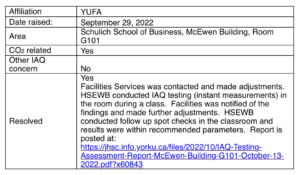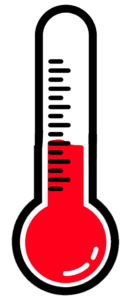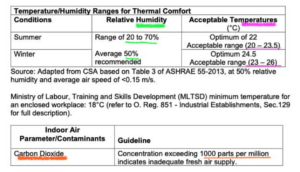
If you feel that it's too hot or too cold in your office or classroom, you wouldn't expect your employer to say "Hey! You can't bring a thermometer into the classroom to measure temperature. You need expert training to read and set up that thermometer."
Of course not. That's ridiculous. And the same goes for air quality sensors that you or grandmother can buy at Canadian Tire or borrow from Toronto Public Library.
Employees at York University are being told by Management that using air quality sensors like CO2 monitors "requires prior training and expertise". This blog post is being written to debunk this assertion. I'm going to do that using two approaches:
- Precedent
- Comparison
But, in short: employees have the right to verify indoor air quality and the employer has the responsibility to not only ensure a good state of indoor air quality but also to follow-up on employee reports and complaints. Temperature, humidity and CO2 levels are all things that the University has stated are important for employees to gauge their indoor air quality -- since at least 2015! (See Appendix A of York's Indoor Air Quality Program document)
Finally, do yourself a favour: read the sensor manual and follow its guidelines. It'll be helpful. You work at a university -- this is definitely something that you should be able to do.
Precedent: Employees already use them to get better air quality
First, it's important to point out that we have precedent for employees using air quality sensors to alert (1) Facilities Services, (2) the Health, Safety and Employee Well Being Department (HSEWB), (3) your Joint Health and Safety Committee (JHSC) and/or (4) your immediate supervisor (Chair, Dean, etc.). It's okay to email all four of them, together, but it's especially important to include the first two.
While many people assume that the people who run the HVAC at the University can monitor air quality in all indoor spaces at all times, that's simply not the case. Facilities Services does not have the capacity, either in terms of employees or in terms of equipment, to monitor all indoor spaces. (see May & August, 2023 HSEC Minutes -- forthcoming) If an HVAC component fails or is set incorrectly, history shows us that Facilities Services often misses it and only discover it when an employee complains.

For example, in September 2022, one of our colleagues at the Schulich School used an Aranet CO2 sensor to alert HSEWB that the ventilation appeared to be poor. The Aranet data, along with a qualitative description of the situation was enough to trigger the investigation. And the outcome of the investigation was that it was confirmed by HSEWB that the ventilation was insufficient and so the HVAC system was turned up to allow more fresh air into the building. (Reference: IAQ Report McEwan Bldg, Sept 2022)
I have personally triggered an investigation into air quality in both Accolade West and the Lassonde Building. Colleagues at Glendon and in Curtis Hall have done likewise. Other employees have done it before, and so can you.
The precedent is set. And has been repeated. HSEWB is required to act on a complaint and will accept your CO2 monitor readings as the basis for conducting the work. Facilities Services will then be required to react to the report and will, hopefully, make the air quality better if it was found to be too low in the first place.
That said, don't expect the higher ventilation rate to remain. The University has a financial incentive to return to a lower ventilation rate as it costs money to power and maintain the HVAC systems that keep the air clean -- it can save a lot of money if it throttles down fresh air delivery, especially in the Winter. Plus, we've had an external consultant come to the University and shown that, historically, elements of our HVAC have been in poor states of repair. Therefore, employees need to be constantly monitoring our indoor air.

Comparison: do you need to be an expert to read a thermometer?
Don't be silly.
No, you don't need to be an expert to read a thermometer.
But there are some "gotchas" that are important to keep in mind.
For example, one of the classic issues with manual thermometers (with the red stuff on the inside), is parallax. You have to read the device from straight on, otherwise the numbers beside the liquid don't line up with the surface of the liquid and your measurement will be off.
But there are other issues, too. Even with modern digital thermometers. Where and when you conduct the measurement is important, as many parents with sick children know. The temperature value will be different if you measure it in the armpit or in the rectum. It may be less accurate if you're measuring on the forehead and it might be higher than expected if you do so right after your kid wakes up. The responsiveness of the thermometer also plays a factor as some lower quality thermometers take tens of seconds or even minutes to stabilize, while some higher quality thermometers can give an accurate reading within seconds -- I know because I've tested them and taught about this in my Sensors and Measurement class at TMU.

Clearly, there are best practices that you should engage in and you'll get better at doing it over time, but no doctor or nurse in their right mind will tell parents to forget about measuring their baby's temperature and head over to the "experts" at the hospital to do it instead. Instead, a responsible medical practitioner will help educate parents about these best practices so that parents can better judge when it's time to go to the Emergency Room, where the nurse or doctor would verify.
Likewise, your employer should encourage you to be vigilant about indoor environmental conditions, like temperature, and should provide you with the tools to help assess them. And even if you miss some of these "gotchas", it shouldn't matter because the ventilation won't be changed simply because you say it should be. As any good carpenter will tell you, you measure twice! Your measurement needs to be verified by dedicated staff with their own equipment. Both HSEWB and Facilities will conduct their own inspections, in their own way. Maybe your measurement will be found to be bang-on. Maybe it will be off a bit, or maybe it will be completely wrong. It doesn't matter. From a workplace health and safety perspective, it's better to be safe than sorry.

Conclusion
There are three elements of indoor air quality that York University specifically refers to in Appendix A of its Indoor Air Quality Program document: temperature, humidity and CO2 levels. This has been in place since 2015. All three are widely recognized as key elements to ensuring that indoor air is healthy and conducive to work and study. Here at York University, indoor temperatures shouldn't exceed 26oC or fall below 20oC, and you should be able to expect that CO2 levels are below 1000 ppm (see annotated copy of Appendix A here).
You have the right to work in an indoor space with clean, properly conditioned air. You have the right to be heard when you have concerns about indoor air quality. When you suspect that air quality is compromised then reach out to the following (at least, here at York University):
- Facilities Services
- the Health, Safety and Employee Well Being Department (HSEWB)
- your Joint Health and Safety Committee (JHSC), and
- your immediate supervisor (Chair, Dean, etc.).
We know that there have been issues with the condition of the HVAC equipment at York University. We also know that it's not possible for Facilities Services to monitor all indoor spaces at all times as they have neither the personnel nor the equipment to do so. Additionally, there have been enough instances of employees discovering that air quality does not meet our own internal guidance that it should come as no surprise that we will continue to find such cases -- many of our buildings are old and ventilation systems don't always work as designed. What's important is that we work, together, to fix the problems. So submit reports when you discover issues and expect that there will be follow-ups.

James Andrew Smith is a Professional Engineer and Associate Professor in the Electrical Engineering and Computer Science Department of York University's Lassonde School, with degrees in Electrical and Mechanical Engineering from the University of Alberta and McGill University. Previously a program director in biomedical engineering, his research background spans robotics, locomotion, human birth and engineering education. While on sabbatical in 2018-19 with his wife and kids he lived in Strasbourg, France and he taught at the INSA Strasbourg and Hochschule Karlsruhe and wrote about his personal and professional perspectives. James is a proponent of using social media to advocate for justice, equity, diversity and inclusion as well as evidence-based applications of research in the public sphere. You can find him on Twitter. Originally from Québec City, he now lives in Toronto, Canada.
Edits:
- on Oct 27 & 28, 2023: clarification, typo fixes, links added, conclusion re-arranged & contacts added, and minor rewording.
- On November 1, 2023: AASHE link added. Link to HSEWB safety programs added. Link to Indoor Air Quality Program main document added.
